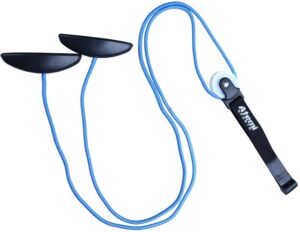Exercises for Frozen Shoulder Using a Physiotherapy Shoulder Pulley

In this post I want to show you a series of exercises for a frozen shoulder which you can do if you want to:
- Relieve shoulder pain
- Increase your range of motion, and
- Speed up the recovery of frozen shoulder syndrome
The best treatment for frozen shoulder will always be the one which works naturally to give you back your freedom of movement without having to put any drugs in your body or resort to surgery.
Doing these exercises for frozen shoulder will allow you to gradually stretch your shoulder joints, increase your range of motion and strengthen your rotator cuff and other muscles essential to shoulder health.
How to Exercise a Frozen Shoulder
When it comes to healing a frozen shoulder, I have good news and bad news. The bad news: this is going to take some work. You need to make the time at least once or twice a day to do these frozen shoulder exercises consistently. You’ll need to do them every day until your shoulder has healed.
The good news is that there’s a simple, inexpensive tool you can use to make these exercises easy, comfortable and maybe even fun.
A physiotherapy shoulder pulley is one of the most effective treatments for frozen shoulder.
To use the shoulder pulley you simply wedge it over the door, between the door and the door frame, as shown here:
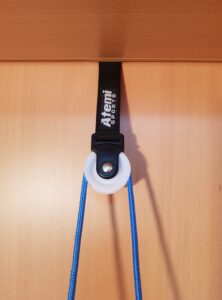
The length of the rope can be adjusted by moving the position of the knot under the handle:

Now you’re ready to start frozen shoulder exercises, sitting in a chair in front of the door:
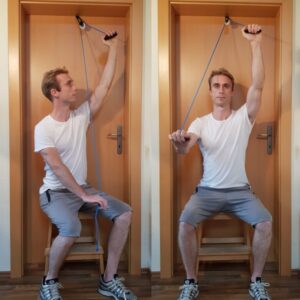
7 Exercises for a Frozen Shoulder with a Physiotherapy Pulley
In order to heal a frozen shoulder, these exercises should be done in the order they’re shown below. You start with easy movements and gradually increase the difficulty as your range of motion improves.
If your frozen shoulder condition is very serious, you may only be able to do the first exercise for several days or even weeks before moving on to the next. If your symptoms are mild, you can proceed through all of the exercises from the beginning. Listen to your body and don’t rush – healing takes time.
If possible, do these frozen shoulder exercises twice a day, every day. Try to do 3 or 4 sets of each exercise, making sure to hold the stretch in the final position for around 10 seconds.
Here’s a video giving you an overview of the exercises and below this we’ve included images and a description of each movement.
#1
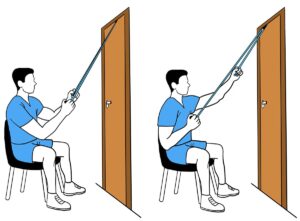
For the first frozen shoulder exercise, sit in a chair facing the door. The uninjured arm will always pull the injured arm (in these images, the left arm is the injured one). As you pull down on one handle, the opposite arm is pulled up and towards the door, gently stretching out the shoulder joint.
#2

For the next exercise, turn your chair 90 degrees so you can do the same exercise with your arm being pulled to the side.
#3

Once your range of motion has improved, turn the chair to face away from the door. Now lift the injured arm directly up in front of you.
#4
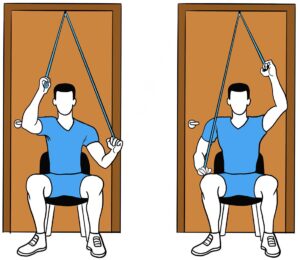
Now change the angle so your arm is at 45 degrees away from your body. Do the same exercise at this angle, stretching the arm as high as you can.
#5

The next movement is the same as the previous two, but this your arm is angled out at 90 degrees to the side.
#6
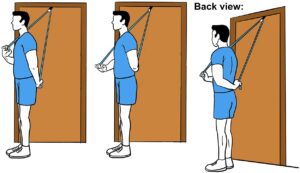
Next, stand up and lift the injured arm up and down behind your back. Start with small movements and gradually increase the range of motion as your shoulder becomes more flexible.
#7
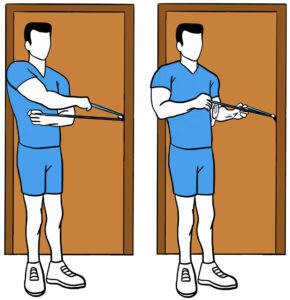
Once you’re comfortable with exercises 1-6, you can begin doing rotational exercises using the physiotherapy pulley. Stand side-on to the door and pull the injured arm in an outward rotating movement.
Keep your shoulder in a natural position – not hunched up or slumped forward. Your elbow should be held fixed at your side without moving around. Keeping a rolled up towel between your body and elbow, as shown, can help with this.
Resistance Band Exercises for a Frozen Shoulder
The 7 exercises above are the basic set of physiotherapy shoulder pulley movements you can do to repair a frozen shoulder safely and effectively. These alone should be enough to ease shoulder pain and increase your range of motion.
To continue to a more advanced level of frozen shoulder exercises, you should aim to improve the strength of your rotator cuff, the group of muscles which are most important to shoulder health.
Doing rotational exercise with a resistance band is one of the best ways to strengthen your rotator cuff muscles. In the below exercise, the shoulder is rotated outwards using a physiotherapy band:

Next, do the same exercise except rotating inwards:
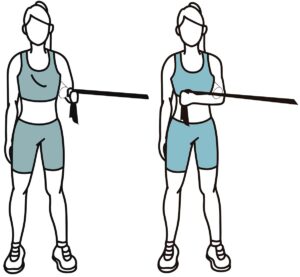
Here’s a video from our YouTube channel showing you how to do these exercises:
You can perform these movements using different kinds of resistance bands. You just need to anchor the band to a fixed point, for example a door handle, and be sure that it’s anchored securely so it won’t snap back at you. You can vary the resistance level by standing closer or further away from the anchor point.
Check out this article for more exercises you can do using physiotherapy bands.

